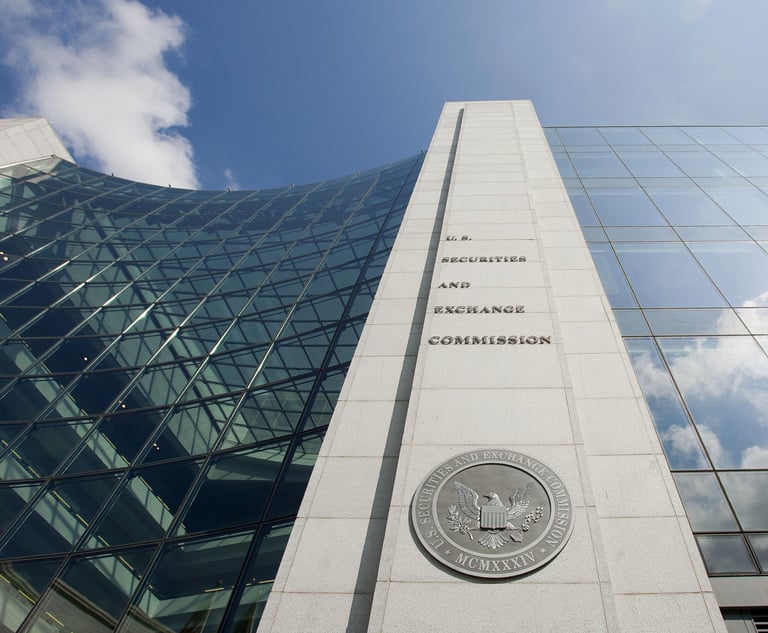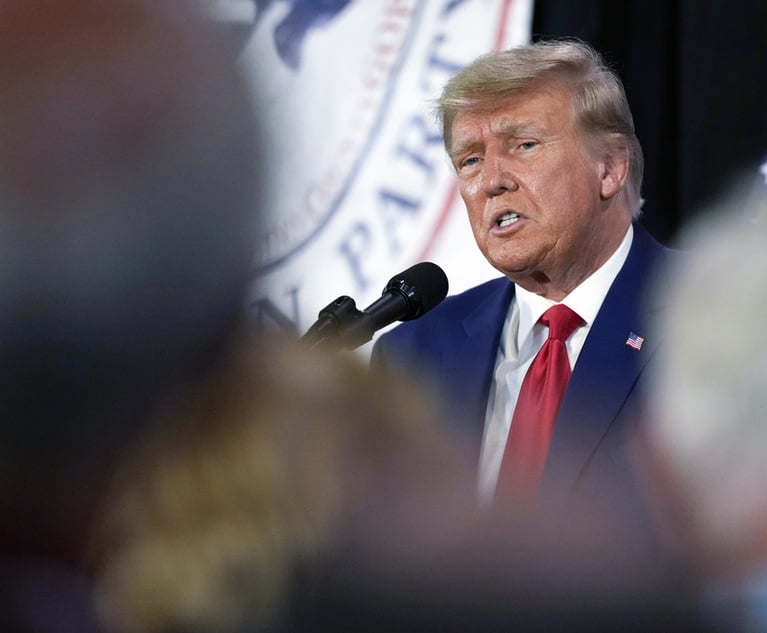The Legal Impact of Drones in the Construction Industry
Until this past Fall there was some uncertainty regarding the commercial use of drones, specifically the use of drones in construction. As of late, there…
August 28, 2017 at 06:29 PM
5 minute read
The original version of this story was published on Law.com
Until this past Fall there was some uncertainty regarding the commercial use of drones, specifically the use of drones in construction. As of late, there have been many legal challenges to the use of drones in construction, including non-registration of drones, invasion of privacy concerns, drone use in restricted areas, potential nuisance claims, and property damage claims caused by wayward drones.
In addition, the requirement in many states is that land surveying work be performed by licensed land surveyors, but drones used for land surveying in construction are often not operated by licensed land surveyors. This is a gray area that will need to be addressed by statute, regulation or case law in each jurisdiction.
Garret Murai, of Wendel Rosen as well as Construction Practice Group co-chair and editor of California Construction Law Blog, sat down with Inside Counsel to discuss the rise of drones in the construction industry and the legal impact surrounding it.
According to the U.S. Federal Aviation Administration (FAA) there were about 42,000 commercial drones in the U.S. in 2016, of which 26 percent were used in construction. While that's a lot of drones, for the FAA, the commercial drone sector is still at an early stage of growth and the number of commercial drones flying above us is expected to increase ten-fold over the next few years to 420,000 commercial drones by 2021. The increasing use of drones in the commercial sector was given a lift when the FAA released its anticipated Small Unmanned Aircraft System regulations. The regulations, which apply to commercial drones, require commercial drones to be registered through FAA's Small Unmanned Aircraft System (sUAS) Registration Service, require FAA certification of UA (unmanned aircraft) pilots and set forth detailed requirements governing the operation of drones.
How does the construction industry legally benefit from using drones?
Per the FAA, drone use in the construction industry falls only behind the use of drones for aerial photography (26 percent vs. 34 percent), although, as one might expect, the construction industry also uses drones for aerial photography as well as for much, much more.
“While the use of drones in the construction industry is still relatively new and will likely expand as new commercial products are developed, today, owners and construction companies have utilized drones to survey project sites, to inspect and track the progress of a construction project, and with the right tools, to turn collected data into topographic maps, to aid in volumetric measurements of stockpiles and to create 3D models,” he explained.
The bottom line benefit for owners and construction companies is that drones can provide information quickly, more frequently and at a fraction of the cost of traditional methods such as manual surveying and aerial photography and can help construction projects run more efficiently, safely and at lower cost, according to Murai.
The most recent data from the U.S. Department of Labor shows that there were 154,000 open construction jobs in the U.S. as of May 2017. While this is below the cyclical high of 238,000 open construction jobs as of June 2016 there continues to be a pronounced labor shortage in the construction industry. Although the construction industry has been on a rebound since 2012, many workers who were forced out following the 2008 real estate crash.
“While efficiency and cost savings have been the primary drivers of the use of drones in the construction industry, with the current construction labor shortage, drones have had the added benefit of allowing fewer people to do more,” said Murai.
According to the U.S. Occupational Safety and Health Administration, one in five worker deaths were in construction. The vast majority of these (38.8 percent) were the result of falls. While they have yet to develop a drone that can perform actual labor, drones can increase worker safety by allowing construction companies to monitor and inspect projects with a degree of detail that would have been impossible before.
He said, “With drones, construction companies can inspect high-up and hard to reach areas of a project and can monitor project sites to ensure that workplace and worker safety standards and regulations are being followed.”
There are key findings that came out of the FAA's drone regulations last September that relate to the construction industry, according to Murai. First, commercial UAs weighing 0.55 pounds up to 55 pounds must be registered through the FAA's sUAS Registration Service. UAs weighing over 55 pounds must seek an exemption from the FAA. Secondly, UAs may only be controlled by a UA pilot certified by the FAA or by someone under the direct supervision UA certified pilot. To become a UA certified pilot a person must either pass an FAA-approved aeronautical test or hold a Part 61 pilot certificate, complete a flight review within the previous 24 months, and complete a UAS online training course. Lastly, UAs may only be operated during daylight or civil twilight hours with anti-collision lighting, may not travel faster 100 mph or fly higher than 400 feet above ground level or within 400 feet of a structure, and UAs may only be flow when there is a minimum weather visibility of three miles from the control station.
This content has been archived. It is available through our partners, LexisNexis® and Bloomberg Law.
To view this content, please continue to their sites.
Not a Lexis Subscriber?
Subscribe Now
Not a Bloomberg Law Subscriber?
Subscribe Now
NOT FOR REPRINT
© 2024 ALM Global, LLC, All Rights Reserved. Request academic re-use from www.copyright.com. All other uses, submit a request to [email protected]. For more information visit Asset & Logo Licensing.
You Might Like
View All
SEC Penalizes Wells Fargo, LPL Financial $900,000 Each for Inaccurate Trading Data

US Reviewer of Foreign Transactions Sees More Political, Policy Influence, Say Observers

Pre-Internet High Court Ruling Hobbling Efforts to Keep Tech Giants from Using Below-Cost Pricing to Bury Rivals
6 minute read
Preparing for 2025: Anticipated Policy Changes Affecting U.S. Businesses Under the Trump Administration
Trending Stories
- 1Advising 'Capital-Intensive Spaces' Fuels Corporate Practice Growth For Haynes and Boone
- 2Big Law’s Year—as Told in Commentaries
- 3Pa. Hospital Agrees to $16M Settlement Following High Schooler's Improper Discharge
- 4Connecticut Movers: Year-End Promotions, Hires and an Office Opening
- 5Luigi Mangione Defense Attorney Says NYC Mayor’s Comments on Case Raise Fair Trial Concerns
Who Got The Work
Michael G. Bongiorno, Andrew Scott Dulberg and Elizabeth E. Driscoll from Wilmer Cutler Pickering Hale and Dorr have stepped in to represent Symbotic Inc., an A.I.-enabled technology platform that focuses on increasing supply chain efficiency, and other defendants in a pending shareholder derivative lawsuit. The case, filed Oct. 2 in Massachusetts District Court by the Brown Law Firm on behalf of Stephen Austen, accuses certain officers and directors of misleading investors in regard to Symbotic's potential for margin growth by failing to disclose that the company was not equipped to timely deploy its systems or manage expenses through project delays. The case, assigned to U.S. District Judge Nathaniel M. Gorton, is 1:24-cv-12522, Austen v. Cohen et al.
Who Got The Work
Edmund Polubinski and Marie Killmond of Davis Polk & Wardwell have entered appearances for data platform software development company MongoDB and other defendants in a pending shareholder derivative lawsuit. The action, filed Oct. 7 in New York Southern District Court by the Brown Law Firm, accuses the company's directors and/or officers of falsely expressing confidence in the company’s restructuring of its sales incentive plan and downplaying the severity of decreases in its upfront commitments. The case is 1:24-cv-07594, Roy v. Ittycheria et al.
Who Got The Work
Amy O. Bruchs and Kurt F. Ellison of Michael Best & Friedrich have entered appearances for Epic Systems Corp. in a pending employment discrimination lawsuit. The suit was filed Sept. 7 in Wisconsin Western District Court by Levine Eisberner LLC and Siri & Glimstad on behalf of a project manager who claims that he was wrongfully terminated after applying for a religious exemption to the defendant's COVID-19 vaccine mandate. The case, assigned to U.S. Magistrate Judge Anita Marie Boor, is 3:24-cv-00630, Secker, Nathan v. Epic Systems Corporation.
Who Got The Work
David X. Sullivan, Thomas J. Finn and Gregory A. Hall from McCarter & English have entered appearances for Sunrun Installation Services in a pending civil rights lawsuit. The complaint was filed Sept. 4 in Connecticut District Court by attorney Robert M. Berke on behalf of former employee George Edward Steins, who was arrested and charged with employing an unregistered home improvement salesperson. The complaint alleges that had Sunrun informed the Connecticut Department of Consumer Protection that the plaintiff's employment had ended in 2017 and that he no longer held Sunrun's home improvement contractor license, he would not have been hit with charges, which were dismissed in May 2024. The case, assigned to U.S. District Judge Jeffrey A. Meyer, is 3:24-cv-01423, Steins v. Sunrun, Inc. et al.
Who Got The Work
Greenberg Traurig shareholder Joshua L. Raskin has entered an appearance for boohoo.com UK Ltd. in a pending patent infringement lawsuit. The suit, filed Sept. 3 in Texas Eastern District Court by Rozier Hardt McDonough on behalf of Alto Dynamics, asserts five patents related to an online shopping platform. The case, assigned to U.S. District Judge Rodney Gilstrap, is 2:24-cv-00719, Alto Dynamics, LLC v. boohoo.com UK Limited.
Featured Firms
Law Offices of Gary Martin Hays & Associates, P.C.
(470) 294-1674
Law Offices of Mark E. Salomone
(857) 444-6468
Smith & Hassler
(713) 739-1250






